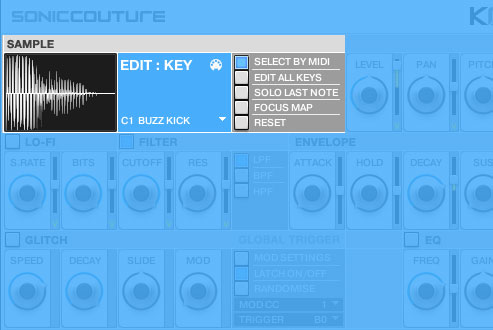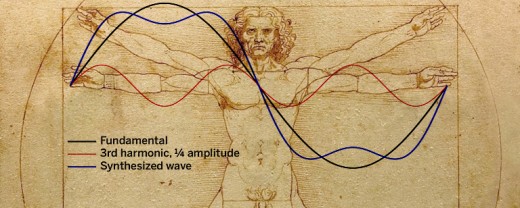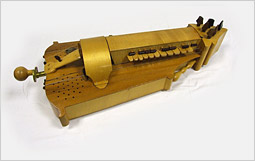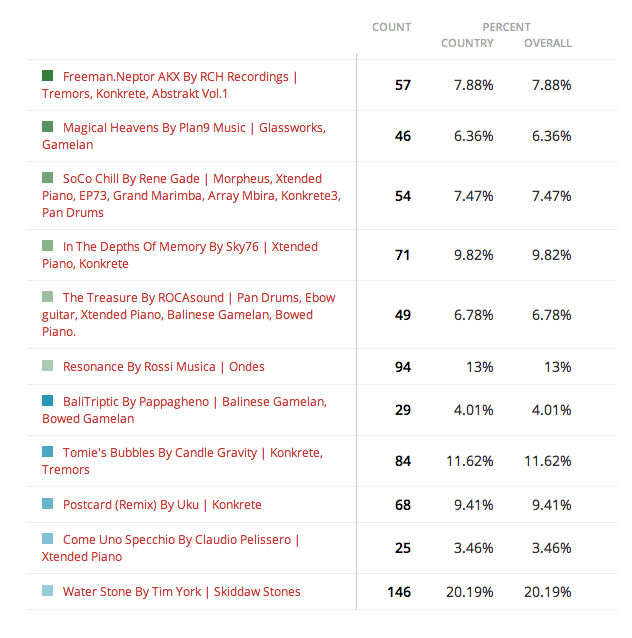Blog Menu
Maschine 2 Konkrete Kits Now Available
Maschine 2 Konkrete Kits Now Available
By James Thompson | 09.01.2014
After receiving a lot of requests to produce Maschine 2 preset files for Konkrete 3, Ed, Le Maschinier, has produced the full set. Konkrete 1, 2 and 3 kits preset files are now available to download for Konkrete 3 users.
The update can be downloaded from the your Soniccouture account.
Read MoreAfter receiving a lot of requests to produce Maschine 2 preset files for Konkrete 3, Ed, Le Maschinier, has produced the full set. Konkrete 1, 2 and 3 kits preset files are now available to download for Konkrete 3 users.
The update can be downloaded from the your Soniccouture account.
Close CloseIn Da Vinci’s Sonic Footsteps
In Da Vinci’s Sonic Footsteps
By James Thompson | 20.11.2013
The music-tech internets lit up this week with news of Slawomir Zubrzycki’s construction of one of Leonardo Da Vinci’s imagined inventions : the Viola Organista :
Read More
LEO Systems Easi-Bow 2000
Several people posted it on our FB page and tweeted us about it in the space of a few hours, and it is clearly an appealing concept : an instrument that bows a string in a very controlled, predictable way, just by pressing a key – rather than the daunting chaos of the violin or the cello. I bet painters wish he’d invented an enigmatic-smile-a-tron as well.
What people may not know is that there are other versions of this idea around; a recent example that leaps to mind is the Wheelharp by Antiquity Music :
Probably the closest DNA match would be the Hurdy Gurdy, the difference being that all the strings on a Hurdy are always in constant contact with the turning wheel.
If Da Vinci had Kontakt..
And, as Dan pointed out to me, our own Bowed Piano (included in the Xtended Piano collection) is a direct virtual equivalent. Using the sustain bow articulation you get the same kind of bowed sound, controllable by a MIDI keyboard. The bowed piano sound is looped in Kontakt, so it directly mirrors the effect of the wheel turning in the Organista.
Close Close
User Tracks Competition: Winner
User Tracks Competition: Winner
By Soniccouture | 25.10.2013
We had over 240 entries for our user tracks competition – music composed using Soniccouture instruments, amongst other sounds of course.
It was a hard and lengthy process to whittle those 200+ down to a shortlist – and a fascinating process during which we learnt a lot about the music people make with our instruments. An invaluable exercise for that reason alone.
But,
Read MoreWe had over 240 entries for our user tracks competition – music composed using Soniccouture instruments, amongst other sounds of course.
It was a hard and lengthy process to whittle those 200+ down to a shortlist – and a fascinating process during which we learnt a lot about the music people make with our instruments. An invaluable exercise for that reason alone.
But, there’s also some great music. There wasn’t really any bad music. Well, hardly any. So, subjective as these things must always be, we tried to take into account, production quality, creativity, interesting use of SC instruments – and stuff we plain old liked – sometimes it’s not so easy to say why. And of course, with any shortlist, it’s fair to say that it could have been a different selection of tracks on a different day – the standard was very high. If your track wasn’t included, don’t take it personally.
Tim York is our winner – here’s a link to his album on Bandcamp
The top 3 tracks as voted for by the public were :
1st Place : Water Stone By Tim York | Skiddaw Stones
2nd Place : Resonance By Rossi Musica | Ondes
3rd Place : Tomie’s Bubbles By Candle Gravity | Konkrete, Tremors
Close CloseThose Eureka Moments..
Those Eureka Moments..
By James Thompson | 15.10.2013
Sampled instrument designers have always struggled with the Vibraphone – the ‘snapshot’ nature of sampling doesn’t really suit it at all; if you sample the single notes, then each notes tremolo will be out of time with the next, and of course the speed will be fixed at one rate anyway. Sometimes people go ahead and sample it anyway, and offer it out of sync with a choice of rates ( fast, medium, slow), but that tends to sound pretty wrong.
Read MoreThe more common ‘workstation’ approach was always to simply switch the motor to off on the Vibraphone, record it static, then fake the tremolo in the synth/sampler using an LFO with a bit of filter and amplitude modulation. Which, in the context of workstation sounds, doesn’t do too bad a job, in that ‘Mock-Tudor’ style that workstation sounds have.
But about a year or 18 months ago, Dan hit on an idea – whether in the bath, I know not – and like many breakthrough ideas, it was beautiful in its simplicity.
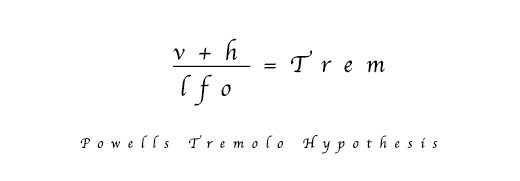
Powell hypothesised that if one recorded the vibraphone twice, in a static state each time, once with the motorised fans fully open, in the vertical position (v) and then again with the fans completely closed, in the horizontal position (h), then by simply crossfading between the two with a simple sine LFO in the sampler, you would get a very natural tremolo effect (Tr).
The only way to test the hypothesis, however, was to actually record the vibraphone – twice – with no real idea if it would actually work ( ie : ‘sound good’) when finished. Bravely we pressed ahead. Enlisting the help of lab assistant Ed, an instrument was sourced (a Yamaha YV-3910M ‘Professional Gold’), and a studio booked for January 2013. For this project we returned to Peter Gabriel’s Real World Studio – a favourite of ours, but one from which we had been away for more than ten years.
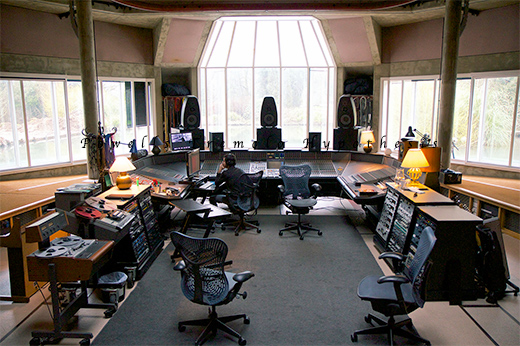
The vibraphone session at Real World. Not as much fun as you might think.
It was a long session- two full 12 hour days listening intently to the metallic ring of the vibraphone key takes its toll on the strongest of men. This was not just one vibraphone sampling session, after all – after we had recorded the entire instrument, every key, with 20+ velocities several times each for round robins, damped and undamped – we then did it all over again again, with the fans closed.
Even once the recording was complete, we were still not able to test Powell’s Hypothesis. First, the samples had to be edited – 3,864 of them, as it turned out. Finally, after months of painstaking work, in the summer of 2013, our small but dedicated team prepared to put the theory into practice.
Did it work? You can judge. Check out our Vibraphone Now!
Close Close
Soniccouture User Tracks Competition
Soniccouture User Tracks Competition
By James Thompson | 25.09.2013
Send Us Your Music, Win $500 of Soniccouture Instruments
We get sent so many great tracks that use our sounds, we really wanted to have a place to keep them all together. So to kick it off, we’ve decided to have a small competition.
Now, this is not a go-and-make-a-remix-type thing or anything that requires much effort, all that is required is to submit any track you have already made (via Soundcloud) that uses a Soniccouture instrument –
Read MoreSend Us Your Music, Win $500 of Soniccouture Instruments
We get sent so many great tracks that use our sounds, we really wanted to have a place to keep them all together. So to kick it off, we’ve decided to have a small competition.
Now, this is not a go-and-make-a-remix-type thing or anything that requires much effort, all that is required is to submit any track you have already made (via Soundcloud) that uses a Soniccouture instrument – free instruments are fine too.
How It Works
First submit your track via the Soundcloud link on this page. All the tracks will then be displayed at the bottom of this page.
After one month, Dan & I will pick a shortlist of our favourite tracks for a public vote.The track with the most votes will win a $500 (€375) voucher to spend in the Soniccouture shop. This voucher can also be kept and used against future purchases and releases.
You will require a Soundcloud account to enter, but we figured most of you will already have one, and if you don’t, well, they’re free and handy to have.
ENTRIES HAVE NOW CLOSED, A SHORTLIST WILL APPEAR.. PRESENTLY
The Winner will be announced October 31st 2013
